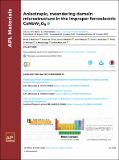Anisotropic, meandering domain microstructure in the improper ferroelectric CsNbW2O9
Abstract
The improper ferroelectric CsNbW2O9 has recently been highlighted as the first material outside the manganite family to exhibit a similar meandering, six-fold domain structure to that responsible for enhanced and diminished conduction at charged domain walls in the rare earth manganites. While there is no current evidence for variation in domain wall conduction relative to bulk in CsNbW2O9, the similarities in microstructure strongly suggest that charged domain walls are present in this material. Herein, we report a comprehensive study of the domain microstructure of CsNbW2O9 using both piezoresponse force microscopy and transmission electron microscopy to reveal that there are, in fact, clear distinctions in the domain structure of the two systems. Constraints arising from the crystal structure of CsNbW2O9, namely, the connectivity of the BO6 polyhedra and atomic displacements occurring purely along the c axis, mean that domain walls preferentially run parallel to the c direction (the polar axis of the material) and thus remain uncharged. The characteristic cloverleaf domain structure reminiscent of the manganites is still present, however, the structure meanders predominantly in the ab plane and, therefore, appears differently depending on the projection direction from which it is viewed. As a result of this microstructural constraint, charged domain walls are not prevalent in this material.
Citation
McCartan , S J , Turner , P W , McNulty , J A , Maguire , J R , McCluskey , C J , Morrison , F D , Gregg , J M & MacLaren , I 2020 , ' Anisotropic, meandering domain microstructure in the improper ferroelectric CsNbW 2 O 9 ' , APL Materials , vol. 8 , no. 10 , 101108 . https://doi.org/10.1063/5.0026040
Publication
APL Materials
Status
Peer reviewed
ISSN
2166-532XType
Journal article
Description
S.J.M acknowledges the EPSRC-funded CDT in Photonic Integration and Advanced Data Storage (EP/L015323/1) for his PhD studentship under which the work at the University of Glasgow was carried out. The work carried out at Queen’s University Belfast and the University of St Andrews was carried out as part of an EPSRC-funded collaboration (EP/P02453X/1 and EP/P024637/1).Collections
Items in the St Andrews Research Repository are protected by copyright, with all rights reserved, unless otherwise indicated.

